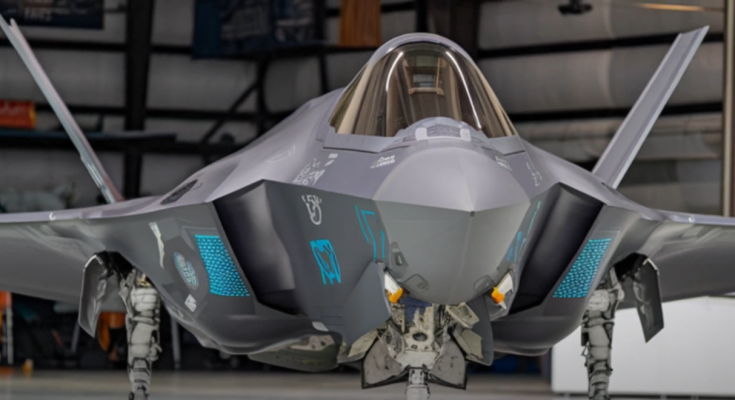The title “This NEW F-35 Just SHOCKED the Entire Military Industry NOW! Here’s Why” likely speaks to the incredible advances being made with the F-35 Lightning II, an aircraft that has already revolutionized modern combat aviation. The F-35 is a fifth-generation multi-role stealth fighter designed by Lockheed Martin to replace a wide range of older aircraft, including the F-16 and F/A-18, as well as provide air forces around the world with unmatched versatility, stealth, and advanced combat capabilities. As the most advanced fighter jet in production today, the F-35 is continually evolving to adapt to the rapidly changing demands of modern warfare. Here’s why the newest version of the F-35 is shaking up the entire military industry.
Unmatched Multirole Capabilities
One of the primary reasons the F-35 is making waves in the military industry is its unprecedented multirole capabilities. Unlike earlier generations of fighter aircraft, the F-35 is not just a dedicated air superiority fighter or a bomber, but a true “jack-of-all-trades” that can perform a wide range of missions. Whether it’s air-to-air combat, close air support, intelligence gathering, or electronic warfare, the F-35 can do it all, making it a more versatile and valuable asset for any air force. The newest iteration of the F-35, which likely includes further refinements, expands its mission capabilities even further, bringing advanced sensors, radar, and payload systems to make it effective in nearly any situation.
Advanced Stealth and Electronic Warfare
The F-35’s stealth technology is one of its most significant advantages. It has been designed from the ground up to evade enemy radar, making it nearly invisible in contested environments. The newest upgrades to the F-35 take this stealth to the next level, incorporating even more advanced materials and techniques to reduce its radar cross-section and enhance its ability to penetrate sophisticated air defense systems. This makes the F-35 an essential asset in the modern era, where air defenses are becoming increasingly advanced.
Furthermore, the F-35 is equipped with an array of electronic warfare capabilities that are designed to disrupt enemy radar and communication systems. The integration of these advanced systems allows the F-35 to operate in complex and highly contested environments where electronic warfare is a key component of modern conflicts. The latest version likely includes even more sophisticated jamming systems, providing the aircraft with a unique advantage over adversaries that rely heavily on radar and sensor-based technologies.
Cutting-Edge Sensors and Situational Awareness
Another game-changing feature of the F-35 is its advanced sensor suite. The F-35 is equipped with an array of cutting-edge sensors that provide pilots with an unprecedented level of situational awareness. The aircraft’s radar, infrared search and track (IRST) system, and distributed aperture system (DAS) combine to create a 360-degree view of the battlefield, allowing pilots to detect and engage targets from greater distances and in more diverse conditions than ever before. This capability is especially valuable in combat situations where the ability to see and act first can be the difference between success and failure.
Recent upgrades likely include further improvements to the sensor fusion technology that allows the aircraft to integrate data from all its systems and present a cohesive picture to the pilot. This reduces the cognitive load on the pilot, allowing them to make better decisions in complex and rapidly evolving combat environments.
Interoperability and Global Reach
The F-35 was designed to be interoperable across different branches of the U.S. military, as well as with allied nations. With its advanced communication systems, the F-35 can share data seamlessly with other assets on the battlefield, including other aircraft, ground units, and even naval ships. This network-centric warfare capability allows for real-time coordination and a level of strategic flexibility that older aircraft simply cannot match. The newest F-35 version has likely enhanced this feature, making it an even more integral component of joint and coalition operations.
Cost Efficiency and Scalability
While the F-35’s price tag has been a point of controversy, ongoing production and continuous upgrades have made it increasingly cost-effective over time. The latest advancements likely focus on reducing the overall cost of maintaining and operating the fleet, which is essential for large-scale, long-term deployment. As more F-35s are delivered to countries around the world, economies of scale come into play, reducing per-unit costs and ensuring that the aircraft remains affordable for nations seeking cutting-edge capabilities without breaking the bank.
Conclusion
The newest version of the F-35 has the potential to completely reshape the future of aerial combat. With its unmatched multirole versatility, advanced stealth and electronic warfare capabilities, cutting-edge sensors, and interoperability with allied forces, the F-35 is set to be the centerpiece of modern air forces for decades to come. If the “new” F-35 has indeed shocked the entire military industry, it is likely due to enhancements that take the already revolutionary aircraft to an even higher level, ensuring that it remains a dominant force in the skies.
In conclusion, the F-35 continues to push the boundaries of what a modern fighter aircraft can do, making it a critical asset in both conventional and future warfare scenarios. The latest updates and capabilities ensure that the F-35 will continue to be a game-changer in the military industry for the foreseeable future.



